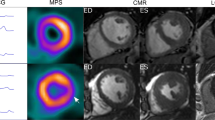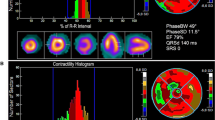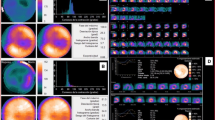Abstract
Background
Fragmented QRS (FQRS) complexes, not typical of a bundle branch block, are a marker of regional myocardial injury. The extent of stress myocardial perfusion imaging (MPI) abnormalities with FQRS patterns is not known.
Methods and Results
Twelve-lead electrocardiograms (ECGs) in 501 patients undergoing stress MPI were studied. FQRS was defined as a QRS duration of 120 milliseconds or less, with notches or slurs of QRS complexes, on 2 contiguous leads of a coronary artery territory. Abnormal MPI was defined as a regional summed stress score (SSS) and summed rest score (SRS) of 3 or greater based on a 17-segment model. Patients with a typical bundle (n=26), paced rhythm (n=2), and Q waves (n=64) were excluded. Of the remaining 409 patients (mean age, 58±13 years; 52% male), 155 (38%) had FQRS on the ECG. FQRS patients had a higher mean SSS, SRS, and global summed difference score and a lower left ventricular ejection fraction (all P<.001), as well as greater regional stress MPI scar (69% vs 11%, P<.001), FQRS pattern sensitivity was 75% and specificity was 94% for a corresponding regional MPI scar. On logistic regression, SSS, SRS, summed difference score, left ventricular ejection fraction, and regional scar were univariate predictors of the FQRS pattern on the ECG (all P<.01), and any regional scar (odds ratio, 32; P<.001) was a multivariate predictor.
Conclusions
FQRS complexes on an ECG are a marker of higher stress MPI perfusion and functional abnormalities. Regional FQRS patterns denote the presence of a greater corresponding focal regional myocardial scar on stress MPI
Similar content being viewed by others
References
Hachamovitch R, Berman DS. New frontiers in risk stratification using stress myocardial perfusion single photon emission computed tomography. Curr Opin Cardiol 2003;18:494–502.
Maddahi J, Kiat H, Van Train KF, Prigent F, Friedman J, Garcia EV, et al. Myocardial perfusion imaging with technetium-99m sestamibi SPECT in the evaluation of coronary artery disease. Am J Cardiol 1990;66:55E-62E.
Berman DS, Hachamovitch R, Kiat H, Cohen I, Cabico JA, Wang FP, et al. Incremental value of prognostic testing in patients with known or suspected ischemic heart disease: a basis for optimal utilization of exercise technetium-99m sestamibi myocardial perfusion single-photon emission computed tomography. J Am Coll Cardiol 1995;26:639–47.
Aboul-Enein FA, Hayes SW, Matsumoto N, Friedman JD, Germano G, Berman DS. Rest perfusion defects in patients with no history of myocardial infarction predict the presence of a critical coronary artery stenosis. J Nucl Cardiol 2003;10:656–62.
Zellweger MJ, Dubois EA, Lai S, Shaw LJ, Amanullah AM, Lewin HC, et al. Risk stratification in patients with remote prior myocardial infarction using rest-stress myocardial perfusion SPECT: prognostic value and impact on referral to early catheterization. J Nucl Cardiol 2002;9:23–32.
Prigent FM, Maddahi, J, Van Train KF, Berman DS. Comparison of thallium-201 SPECT and planar imaging methods for quantification of experimental myocardial infarct size. Am Heart J 1991; 122:972–9.
Varriale P, Chryssos BE. The RSR’ complex not related to right bundle branch block: diagnostic value as a sign of myocardial infarction scar. Am Heart J 1992;123:369–76.
Gardner PI, Ursell PC, Fenoglio JJ Jr, Wit AL. Electrophysiologic and anatomic basis for fractionated electrograms recorded from healed myocardial infarcts. Circulation 1985;72:596–611.
el-Sherif N. The rsR’ pattern in left surface leads in ventricular aneurysm. Br Heart J 1970;32:440–8.
Reddy CV, Cheriparambill K, Saul B, Makan M, Kassotis J, Kumar A, et al. Fragmented left sided QRS in absence of bundle branch block: sign of left ventricular aneurysm. Ann Noninvasive Electrocardiol 2006;11:132–8.
Grady TA, Chiu AC, Snader CE, Marwick TH, Thomas JD, Pashkow FJ, et al. Prognostic significance of exercise-induced left bundle-branch block. JAMA 1998;279:153–6.
Dhingra R, Pencina MJ, Wang TJ, Nam BH, Benjamin EJ, Levy D, et al. Electrocardio graphic QRS duration and the risk of congestive heart failure: the Framingham Heart Study. Hypertension 2006;47: 861–7.
Das MK, Khan B, Jacob S, Kumar A, Mahenthiran J. Significance of a fragmented QRS complex versus a Q wave in patients with coronary artery disease. Circulation 2006;113:2495–501.
Cerqueira MD, Weissman NJ, Dilsizian V, Jacobs AK, Kaul S, Laskey WK, et al. Standardized myocardial segmentation and nomenclature for tomographic imaging of the heart: a statement for healthcare professionals from the Cardiac Imaging Committee of the Council on Clinical Cardiology of the American Heart Association. Circulation 2002;105:539–42.
Sandler LL, Pinnow EE, Lindsay J. The accuracy of electrocardiographic Q waves for the detection of prior myocardial infarction as assessed by a novel standard of reference. Clin Cardiol 2004; 27:97–100.
Friedman BM, Dunn MI. Postinfarction ventricular aneurysms. Clin Cardiol 1995;18:505–11.
Ward RM, White RD, Ideker RE, Hindman NB, Alonso DR, Bishop SP, et al. Evaluation of a QRS scoring system for estimating myocardial infarct size. IV. Correlation with quantitative anatomic findings for posterolateral infarcts. Am J Cardiol 1984;53:706–14.
Yasuda M, lida H, Itagane H, Tahara A, Toda I, Akioka K, et al. Significance of Q wave disappearance in the chronic phase following transmural acute myocardial infarction. Jpn Circ J 1990;54:1517–24.
Furman MI, Dauerman HL, Goldberg RJ, Yarzebski J, Lessard D, Gore JM. Twenty-two year (1975 to 1997) trends in the incidence, in-hospital and long-term case fatality rates from initial Q-wave and non-Q-wave myocardial infarction: a multihospital, community-wide perspective. J Am Coll Cardiol 2001;37:1571–80.
Selvester RH, Wagner GS, Hindman NB. The Selvester QRS scoring system for estimating myocardial infarct size. The development and application of the system. Arch Intern Med 1985;145: 1877–81.
Moka D, Baer FM, Theissen P, Schneider CA, Dietlein M, Erdmann E, et al. Non-Q-wave myocardial infarction: impaired myocardial energy metabolism in regions with reduced 99mTc-MIBI accumulation. Eur J Nucl Med 2001;28:602–7.
Christian TF, Clements JP, Gibbons RJ. Noninvasive identification of myocardium at risk in patients with acute myocardial infarction and nondiagnostic electrocardiograms with technetium-99m-sestamibi. Circulation 1991;83:1615–20.
Sharir T, Berman DS, Waechter PB, Areeda J, Kavanagh PB, Gerlach J, et al. Quantitative analysis of regional motion and thickening by gated myocardial perfusion SPECT: normal heterogeneity and criteria for abnormality. J Nucl Med 2001; 42:1630–8.
Palmas W, Friedman JD, Diamond GA, Silber H, Kiat H, Berman DS. Incremental value of simultaneous assessment of myocardial function and perfusion with technetium-99m sestamibi for prediction of extent of coronary artery disease. J Am Coll Cardiol 1995;25:1024–31.
Gibbons RJ. Technetium 99m sestamibi in the assessment of acute myocardial infarction. Semin Nucl Med 1991;21:213–22.
Hachamovitch R, Berman DS, Shaw LJ, Kiat H, Cohen I, Cabico JA, et al. Incremental prognostic value of myocardial perfusion single photon emission computed tomography for the prediction of cardiac death: differential stratification for risk of cardiac death and myocardial infarction. Circulation 1998;97:535–43.
Flowers NC, Horan LG, Tolleson WJ, Thomas JR. Localization of the site of myocardial scarring in man by high-frequency components. Circulation 1969;40:827–34.
Lesh MD, Spear JF, Simson MB. A computer model of the electrogram: what causes fractionation? J Electrocardiol 1988; 21(Suppl):S69–73.
Author information
Authors and Affiliations
Corresponding author
Rights and permissions
About this article
Cite this article
Mahenthiran, J., Khan, B.R., Sawada, S.G. et al. Fragmented QRS complexes not typical of a bundle branch block: A marker of greater myocardial perfusion tomography abnormalities in coronary artery disease. J Nucl Cardiol 14, 347–353 (2007). https://doi.org/10.1016/j.nuclcard.2007.02.003
Received:
Accepted:
Issue Date:
DOI: https://doi.org/10.1016/j.nuclcard.2007.02.003




